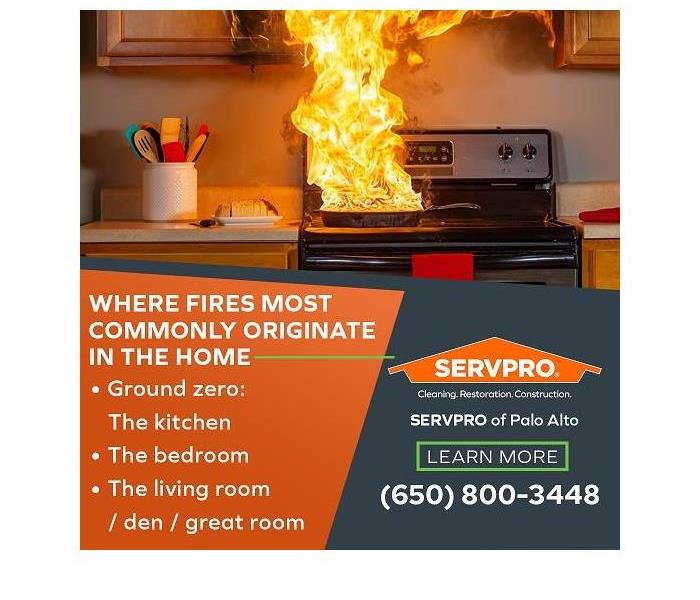Analyzing the Locations Where Fires Frequently Start in the Home and Cause Fire Damage
11/24/2022 (Permalink)
Blog Summary: SERVPRO of Palo Alto warns homeowners about the places where fire damage frequently originates in the home.
SERVPRO® of Palo Alto highlights three rooms in the home where fire and fire damage commonly originate: the kitchen, the bedroom, and the living room. The team of IICRC-certified property damage restoration professionals also offers top fire safety tips to keep life in the home safe from fire.
Where fires most commonly originate in the home
Residential house fires account for approximately one-fourth of reported fire events in the United States each year. The majority of fire-related fatalities occur during a house fire.
Two factors give the homeowner a decided advantage when it comes to surviving a house fire:
- Knowing where a house fire most commonly originates
- Knowing when house fires are most likely to occur
Ground zero: The kitchen
The kitchen is ground zero for house fires. Most house fires start in the kitchen, with unattended meals cooking on the stove being the flashpoint. Most fire-related injuries occur in the kitchen, the heart of the home. Fortunately, flaming meals on the stovetop are very preventable, with only a few changes in cooking practices.
Top safety tips: The kitchen
- Eyes must always be on the stove, oven, and toaster oven.
- Keep dishcloths, rags, paper towels, and flammable liquids away from hot burners.
- Never leave the kitchen when cooking with high heat (frying, boiling, or broiling).
- If life situations take the cook away from the kitchen, ALWAYS turn off hot burners and make sure handles are not accessible to curious hands (or paws) from below.
- When cooking is completed, remember to turn off all burners.
- Avoid storing pots and pans on the stove when not in use. If a stove eye were to be left on, great personal injury could result.
- Dress for safety. Do not wear baggy sleeves. Wear a tight apron over loose, flowing clothing to avoid catching fire.
- Do not rely on the oven for household heating needs.
- Keep a Class B fire extinguisher handy and train capable children and adults to properly use the device.
- Never douse a cooking fire with water. Keep pot lids nearby to cover the dish in case it bursts into flames.
The kitchen should receive great attention because of the high-risk dangers of fire, personal injury, and death. Remember, it only takes a few seconds for a small flame to become a raging blaze.
The bedroom
Electrical fires most often originate in a bedroom. Because these fires typically start when people are asleep, the potential for serious injury or death is very high. The main culprits are overloaded circuits or faulty lighting fixtures, but damaged or overloaded extension cords are also sources of fire in the bedroom. Space heaters and electric blankets carry high-risk hazards. The abundance and types of fabrics and other flammable materials (carpeting, drapes, magazines, books, papers, and bedding) in the bedroom provide ample fuel for the flames.
Top safety tips: The bedroom
- Repair or replace outlets that are worn out, cracked, or malfunctioning.
- Immediately replace damaged or worn power cords as soon as they show signs of wear. Exposed wires are a sure sign that the item needs to be taken out of service and discarded.
- Avoid overloading wiring and circuits with power strips.
- Unplug devices when not in use.
- Keep heating devices, especially space heaters, at least three feet from combustibles.
- Teach children not to play with matches or lighters in the home. Four in ten home fires started by children originate in the bedroom.
The living room/den/great room
The living room is where life happens in the home. A cozy fireplace or warm wood stove can often be found here. Yet, the second leading cause of house fires is the very thing that makes the home so cozy, relaxing, and peaceful: heating equipment, primarily chimneys.
Top safety tips: The living room
Listed below are some safety tips to help keep wood stoves, fireplaces, chimneys, and space heaters safe.
- Have the chimney, fireplace, and wood stove inspected and cleaned by a professional in the fall before the full brunt of winter hits.
- Maintain at least a three-foot zone around the heat source free of combustibles.
- Invest in a better-quality fireplace screen to prevent sparks from escaping.
- Practice total fire safety: Never leave a fire unattended, and always completely extinguish the fire before going to bed or leaving the home.
- Heat with cured hardwoods in the fireplace and wood stove.
- Teach children proper fire safety, including staying at least three feet away from the heat source. Pets and children should be under adult supervision when the fireplace or wood stove is in use.
The top safety tip: Smoke detectors throughout the home
Install smoke detectors throughout the house to alert everyone anywhere in the home of the danger of fire. Smart technology allows for all smoke detectors to be connected so that when one is activated, all detectors activate. First responders can be notified through the internet when an alert system activates.
In case of fire damage in the home, SERVPRO® of Palo Alto is available 24 hours a day, 365 days a year, to help stabilize the situation and begin the restoration process. A rapid response and a quick fire damage cleanup process enable life to return to normal as soon as possible.
To learn more about residential fire damage restoration services in Permanente, CA, and surrounding communities, contact SERVPRO of Palo Alto by phone at (650) 800-3448 or email office@SERVPROpaloalto.com.



 24/7 Emergency Service
24/7 Emergency Service
